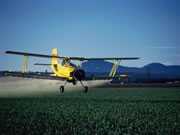Water Contamination
Overview
Over the past few decades, the increase in population and advances made in farming technology has increased the demand for crops and livestock from the agricultural industry. This growth in agricultural production has resulted in an increase in contaminants polluting soil and waterways. The increase in contaminants has prompted efforts to reduce the amount of pollutants in waterways in order to improve overall water quality.
Sources
Agriculture in many parts of the world is highly efficient in producing and delivering high-quality products to consumers. However, when agricultural activities are not well-monitored and managed, certain practices can negatively affect water quality.
Agricultural Runoff

According to the U.S. Environmental Protection Agency (EPA), nonpoint source (NPS) pollution is pollution that comes from many diffuse sources, unlike pollution from point sources such as industrial and sewage treatment plants. “Polluted runoff is created by rainfall or snowmelt moving over and through the ground. As the runoff moves, it picks up and carries away natural and human-made pollutants, finally depositing them into watersheds via lakes, rivers, wetlands, coastal waters, and even our underground sources of drinking water” (1).
In 2002, in the National Water Quality Inventory report to U.S. Congress, the states reported that agricultural nonpoint source (NPS) pollution is the leading cause of river and stream impairment and the second leading cause of impairment in lakes, ponds, and reservoirs (2).
Agricultural activities that cause nonpoint source pollution include:
- Poorly managed animal feeding operations
- Overgrazing
- Overworking the land (for example, plowing too often)
- Poorly managed and ineffective application of pesticides, irrigation water, and fertilizer
Effects
Agricultural water can become contaminated through a variety of ways and can potentially spread bacteria, viruses, and parasites to crops and animals.
Crop Production
Fresh fruits and vegetables come in contact with water during various stages of the production process. Contaminated water that is used during crop production, harvesting, and processing can lead to health issues.
Below is a list of the potential food production points where contaminated water sources can affect crop production:
- Chemical Application
Crops with contaminated water used for pesticide or herbicide application. Water used for mixing chemicals should be of appropriate quality. - Irrigation
Irrigating crops with contaminated water. Water used for irrigation should be of appropriate quality. - Worker Hygiene
Lack of potable water for hand hygiene. There should be an established handwashing and hygiene policy for farm workers. - Food Processing
Wash crops in the final wash process with quality water. Water should be of drinking water quality and should not be recycled (3).
People who consume fruit or vegetables that were exposed to contaminated water are at risk of developing a foodborne illness. Some of the bacteria that are spread through water within the United States include E. coli, Salmonella spp., Shigella spp., Cryptosporidium, Giardia, Toxoplasma, norovirus, and hepatitis A virus. Irrigation of foods imported from international locations can spread these and other microbes (for example, Cyclospora) not usually found in developed countries. Small amounts of any of these organisms can cause foodborne illness. In order to keep microbes out of water sources, growers should use practices that are appropriate for their operation and make sure that they are using the best quality water (4). Water quality is also important in ensuring post harvest quality by decreasing decay (5).
Animal Health
It is important that livestock are provided with adequate amounts of quality water, free of contamination. Contaminated water can contain disease-causing organisms which can rapidly spread if animals are drinking from the same trough. If there is reason to question the quality of the water that is provided to livestock, it is important to test the water to ensure its safety. There are many chemicals and microorganisms that can be potentially dangerous to livestock. Some chemicals include nitrates, sulfates, and chemicals found in pesticides like DDT, Chlordane, and Endrin. Certain microorganisms such as blue-green algae, Cryptosporidium, or Staphylococcus, can be toxic to animals and cause symptoms like diarrhea, lack of coordination, labored breathing, or death (6). Ill animals can then release millions of infectious microbes into the soil that can further contaminate other water sources.
References
- U.S. Environmental Protection Agency. Protecting Water Quality from Agricultural Runoff. March 2005. Available at http://www.epa.gov/owow/nps/Ag_Runoff_Fact_Sheet.pdf [PDF - 120 kb].
- U.S. Environmental Protection Agency. National Water Quality Inventory: Report to Congress, 2002 Reporting Cycle: Findings, Rivers and Streams, and Lakes, Ponds and Reservoirs. Available at http://www.epa.gov/305b/2002report/report2002pt3.pdf [PDF - 2.35 mb].
- Roper, T. Producer’s Guide to Reducing Microbial Contamination of Fresh Produce. University of Wisconsin Extension, 1999. A3701.
- Gast, K & Holt, K. Minimizing Microbial Hazards for Fresh Fruits and Vegetables, Agricultural Water, Kansas State University, 2000 Dec. 4, p. MF-2479.
- Rangarajan A, Bihn E, Gravani R, Scott D, Pritts, M. Food Safety Begins on the Farm: A Grower’s Guide. Cornell Good Agricultural Practices Program, 2000.
- Boyles, S. Livestock and Water. Ohio State University Extension. Available at http://beef.osu.edu/library/water.html.
- Page last reviewed: October 11, 2016
- Page last updated: October 11, 2016
- Content source:


 ShareCompartir
ShareCompartir